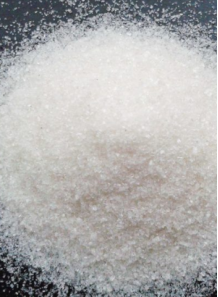Ammonium Sulfate
an inorganic salt with a variety of industrial, agricultural and laboratory uses—but it offers no direct health benefits to humans when consumed
an inorganic salt with a variety of industrial, agricultural and laboratory uses—but it offers no direct health benefits to humans when consumed
Ammonium sulfate ((NH₄)₂SO₄) is an inorganic salt with a variety of industrial, agricultural and laboratory uses—but it offers no direct health benefits to humans when consumed. Below is a concise overview of its functions and safety considerations:
-
No Nutritional Value or Therapeutic Effect
As a food additive (E-number E517), ammonium sulfate is used solely as an acidity regulator and dough conditioner. It does not contribute vitamins, minerals, or any bioactive compounds beneficial to human health. Regulatory bodies classify it as “generally recognized as safe” (GRAS), but explicitly note that it provides no health benefits to consumers. -
Indirect, Plant-Level Benefits
-
Fertilizer: Supplies 21% nitrogen and 24% sulfur, essential macronutrients for plant growth. Improves crop yield, accelerates stem development, and can enhance taste and appearance of produce.
-
Soil pH Adjustment: The ammonium ion acidifies alkaline soils, increasing availability of phosphorus and micronutrients (iron, zinc, etc.) to plant roots.
By boosting agricultural productivity, it indirectly supports human nutrition by helping to ensure a robust food supply—but these are plant-level benefits, not a supplement for human consumption.
-
-
Laboratory and Industrial Uses
-
Protein Purification: A cornerstone reagent for “salting out” proteins via ammonium sulfate precipitation in biochemistry and antibody purification.
-
Vaccine Excipient: Listed as an inert ingredient in some vaccine formulations (per CDC), but again serves a formulation/stabilization role, not a pharmacological one.
-
-
Potential Health Risks
-
Irritation: Inhalation or contact can irritate the eyes, skin, and respiratory tract.
-
Long-Term Exposure: May exacerbate respiratory issues; environmental concerns include soil acidification and water eutrophication if over-applied in agriculture.
-
Toxicity: Oral LD₅₀ in rats is ~2,840 mg/kg, indicating moderate acute toxicity at high doses
-
| Mechanism | - |
| Appearance | - |
| Longevity | - |
| Strength | - |
| Storage | - |
| Shelf Life | - |
| Allergen(s) | - |
| Dosage (Range) | - |
| Recommended Dosage | - |
| Dosage (Per Day) | - |
| Recommended Dosage (Per Day) | - |
| Mix Method | - |
| Heat Resistance | - |
| Stable in pH range | - |
| Solubility | - |
| Product Types | - |
| INCI | - |
Purchase History for
Cart
No products



